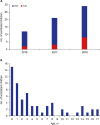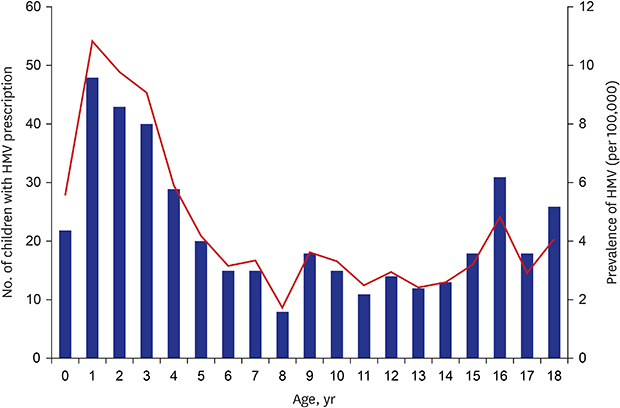1. Simonds AK. Home ventilation. Eur Respir J Suppl. 2003; 47(47 Suppl):38s–46s.

2. Lloyd-Owen SJ, Donaldson GC, Ambrosino N, Escarabill J, Farre R, Fauroux B, et al. Patterns of home mechanical ventilation use in Europe: results from the Eurovent survey. Eur Respir J. 2005; 25(6):1025–1031.

3. Mehta S, Hill NS. Noninvasive ventilation. Am J Respir Crit Care Med. 2001; 163(2):540–577.

4. Graham RJ, Fleegler EW, Robinson WM. Chronic ventilator need in the community: a 2005 pediatric census of Massachusetts. Pediatrics. 2007; 119(6):e1280–e1287.

5. Gowans M, Keenan HT, Bratton SL. The population prevalence of children receiving invasive home ventilation in Utah. Pediatr Pulmonol. 2007; 42(3):231–236.

6. Fauroux B, Sardet A, Foret D. Home treatment for chronic respiratory failure in children: a prospective study. Eur Respir J. 1995; 8(12):2062–2066.

7. Fauroux B, Boffa C, Desguerre I, Estournet B, Trang H. Long-term noninvasive mechanical ventilation for children at home: a national survey. Pediatr Pulmonol. 2003; 35(2):119–125.

8. Jardine E, O'Toole M, Paton JY, Wallis C. Current status of long term ventilation of children in the United Kingdom: questionnaire survey. BMJ. 1999; 318(7179):295–299.

9. Jardine E, Wallis C. UK Working Party on Paediatric Long Term Ventilation. Core guidelines for the discharge home of the child on long-term assisted ventilation in the United Kingdom. Thorax. 1998; 53(9):762–767.
10. Wallis C, Paton JY, Beaton S, Jardine E. Children on long-term ventilatory support: 10 years of progress. Arch Dis Child. 2011; 96(11):998–1002.

11. Robinson RO. Ventilator dependency in the United Kingdom. Arch Dis Child. 1990; 65(11):1235–1236.

12. Ahn YJ, Lee SH, Kim HB, Park SJ, Ko TS, Hong SJ. Clinical study of children using home mechanical ventilation. Korean J Pediatr. 2005; 48(4):401–405.
13. Han YJ, Park JD, Lee B, Choi YH, Suh DI, Lim BC, et al. Home mechanical ventilation in childhood-onset hereditary neuromuscular diseases: 13 years' experience at a single center in Korea. PLoS One. 2015; 10(3):e0122346.

14. Kim HI, Cho JH, Park SY, Lee YS, Chang Y, Choi WI, et al. Home mechanical ventilation use in South Korea based on national health insurance service data. Respir Care. 2019; 64(5):528–535.

15. Sakakihara Y, Yamanaka T, Kajii M, Kamoshita S. Long-term ventilator-assisted children in Japan: a national survey. Acta Paediatr Jpn. 1996; 38(2):137–142.

16. Kamma M, Burgerb R, Rimensbergerc P, Knoblauchd A, Hammera J. Survey of children supported by long-term mechanical ventilation in Switzerland. Spinal Cord. 2001; 2:6.
17. Paulides FM, Plötz FB, Verweij-van den Oudenrijn LP, van Gestel JP, Kampelmacher MJ. Thirty years of home mechanical ventilation in children: escalating need for pediatric intensive care beds. Intensive Care Med. 2012; 38(5):847–852.

18. Amin R, Sayal P, Syed F, Chaves A, Moraes TJ, MacLusky I. Pediatric long-term home mechanical ventilation: twenty years of follow-up from one Canadian center. Pediatr Pulmonol. 2014; 49(8):816–824.

19. Racca F, Bonati M, Del Sorbo L, Berta G, Sequi M, Capello EC, et al. Invasive and non-invasive long-term mechanical ventilation in Italian children. Minerva Anestesiol. 2011; 77(9):892–901.
20. Edwards EA, Hsiao K, Nixon GM. Paediatric home ventilatory support: the Auckland experience. J Paediatr Child Health. 2005; 41(12):652–658.

21. Oktem S, Ersu R, Uyan ZS, Cakir E, Karakoc F, Karadag B, et al. Home ventilation for children with chronic respiratory failure in Istanbul. Respiration. 2008; 76(1):76–81.

22. Racca F, Berta G, Sequi M, Bignamini E, Capello E, Cutrera R, et al. Long-term home ventilation of children in Italy: a national survey. Pediatr Pulmonol. 2011; 46(6):566–572.

23. Make BJ, Hill NS, Goldberg AI, Bach JR, Criner GJ, Dunne PE, et al. Mechanical ventilation beyond the intensive care unit. Report of a consensus conference of the American College of Chest Physicians. Chest. 1998; 113(5 Suppl):289S–344S.
24. Bertrand P, Fehlmann E, Lizama M, Holmgren N, Silva M, Sánchez I. Home ventilatory assistance in Chilean children: 12 years' experience. Arch Bronconeumol. 2006; 42(4):165–170.

25. Tibballs J, Henning R, Robertson CF, Massie J, Hochmann M, Carter B, et al. A home respiratory support programme for children by parents and layperson carers. J Paediatr Child Health. 2010; 46(1-2):57–62.











 PDF
PDF Citation
Citation Print
Print




 XML Download
XML Download